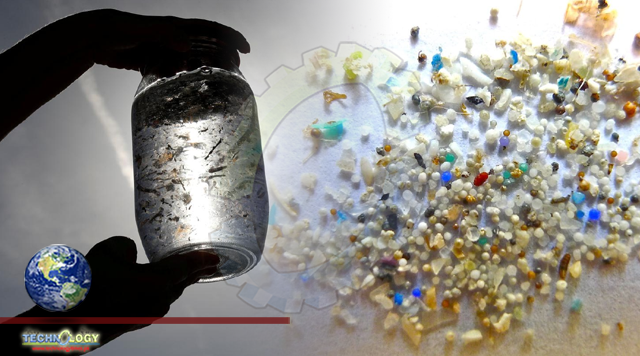Maria-Luiza Pedrotti, CNRS marine biologist specialised in microplastics, looks at sea sample taken from the Mediterraneean Sea on a coastal research vessel as part of a scientific study about microplastics damaging marine ecosystems, near Villefranche-Sur-Mer, on the French Riviera, France.

By ELIZABETH CLAIRE ALBERTS
Plastic is everywhere — literally everywhere. A growing body of research shows that plastic is not only filling the world’s oceans and wilderness regions, it’s also invading our bodies through the air we breathe, the water we drink and the food we consume.
And now, a new study has shown that microplastics — tiny plastic particles smaller than 5 millimetres but bigger than 1 micron — are even present inside human placentas, posing a potential risk to foetal health and development.
Published this month in Environmental International, the study examined six human placentas from women who experienced healthy pregnancies and births.
During delivery, the obstetricians and midwives followed a “plastic-free protocol,” swapping plastic gloves for cotton ones, and not using any plastic equipment or supplies to avoid cross-contamination.
The researchers found a total of 12 microplastic fragments in four of the six placentas. Three of these pieces were recognized as polypropylene, a plastic commonly used in food containers and packaging.
While the other pieces were harder to identify, they appeared to be plastic bits from “man-made coatings, paints, adhesives, plasters, finger paints, polymers and cosmetics and personal care products,” according to the study.
The effects of microplastics in the human body on health are still largely unknown, but the researchers said it was “a matter of great concern” due to the critical role the placenta plays in foetal development.
Lead author Antonio Ragusa, director of obstetrics and gynaecology at the San Giovanni Calibita Fatebenefratelli hospital in Rome, said it’s likely that microplastics would be present in the babies themselves, although further research would need to confirm this.
“I cannot support it with scientific evidence, since ours is the first study in the world on this topic, [but] I think that if we could look for them we will also find microplastics in the organs of the newborn, because the placenta is a temporary foetal organ, and not a maternal organ,” Ragusa told Mongabay in an emailed statement. “Of course this is just a guess.”
While all of the babies were healthy at birth, Ragusa said that the microplastics in the placenta had the potential to “alter several cellular regulating pathways … such as immunity mechanisms.”
“The presence of MPs [microplastics] in the placenta tissue requires the reconsideration of the immunological mechanism of self-tolerance, a mechanism that may be perturbed by the presence of MPs,” Ragusa said.
“In fact, it is reported that, once present in the human body, MPs may accumulate and exert localised toxicity by inducing and/or enhancing immune responses and, hence, potentially reducing the defense mechanisms against pathogens and altering the utilisation of energy stores.”
The researchers say it’s likely that the microplastics entered the mothers’ bodies through food ingestion or through respiration, and then translocated into the placentas.
Steve Allen, a microplastics researcher from the University of Strathclyde in Glasgow, who was not involved in the study, said he wasn’t surprised by the findings: “I’d say with complete confidence that using the right tools, we will find it in every part of the human body.”
A similar study has shown that pregnant rats forced to inhale nanoplastics ended up having particles present in their placentas, as well as the foetal liver, lungs, heart, kidney and brain.
“Considering it can move through rats like that, I wouldn’t be surprised if it can do exactly the same thing to humans,” said Deonie Allen, also a microplastics researcher at the University of Strathclyde.
Ragusa says he and his colleagues will be doing further research on microplastics with regard to maternal and infant health.
“We now have to understand if microplastics are present in the newborn at birth and we will do it by taking the umbilical cord blood at birth,” he said. “Another important step will be to understand if microplastics are present in breast milk.”
Originally published at Science the wire